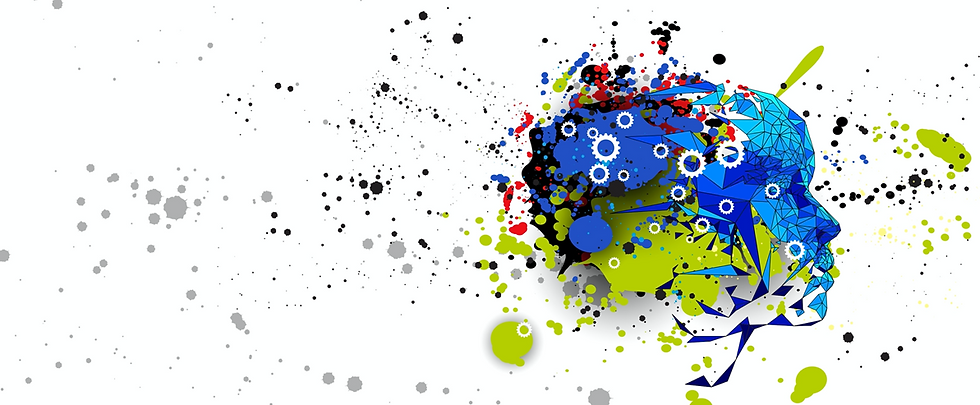Design Thinking
- Rashmi Thakur

- Jan 25, 2020
- 4 min read
Updated: Jun 17, 2021
Reskilling in the modern world
Within the past two years many of my clients from diverse industries such as Banking, Technology, Retail, Fintech, Healthcare among others, have introduced Design Thinking into their organisations. Design Thinking is becoming a key ingredient in their transformation, innovation and experience journey. Organisations are looking for an approach that can help them in designing responses to the complexity, ambiguity, disruptions and rapidly changing behaviours.
Entrepreneurs as well as employees from different disciplines across the organisations are enthusiastically learning the new skills of design thinking which they wish to apply in a practical way at their work, for solving problems.
What is Design Thinking?
Design Thinking is a creative problem solving approach; it is a human-centred way to frame and solve problems. It is multidisciplinary at its core and integrates approaches, tools and techniques from different fields (Psychology, Design, Business, Ethnographic Research, Marketing and Technology) in a simple and pragmatic manner.

Design thinking helps us to gather unbiased insights about the people. It emphasises on a lot of experimentation. It believes in diverging into a host of ideas before converging into solutions. It applies to designing products, services, experiences and all other areas which are people centric.
Design thinking is one of the skills that makes us people oriented and it also equips us with creative problem solving. It is solving a key challenge of understanding people for creating successful solutions for companies and society. It gives us a different lens and a new set of eyes for us to reimagine. It gives a balance to our digital skills – and that becomes a great differentiator. It blends human emotions with data to uncover insights. It helps in a holistic thinking for designing responses to our challenges.
Design Thinking has become very popular
Design Thinking has become very popular as it helps in transforming organisations from legacy to people centric and balances the insights gained from big data. It embeds a culture of innovation in the organisations through the mindset of empathy, experimentation and collaboration.

Design Thinking can deliver an ROI of 85% or greater
Design thinking has historically enjoyed blind support among executive leaders based on its perceived value. According to Forrester, Design Thinking can deliver an ROI of 85% or greater. Forrester created a Total Economic Impact™ (TEI) model to empower design thinking practitioners with the tools needed to quantify their efforts as well as form a compelling business case for the practice.
Design-centric companies show a 211% return over the S&P 500
The Design Management Institute’s 2016 Design Value Index (DVI), based on a portfolio of 16 publicly traded stocks from companies considered to be “design-centric” shows a 10 years return yield of 211% over the S&P 500.

Design thinking paying off
DBS Bank
Chooake Wongwattanasilpa, Executive Director, User Experience & Design, DBS Bank, Consumer Banking Group
We combine classical design, design thinking and computational design for our products. We leverage on the latest technology to build our products, and also ensure our creations encompass the classical principles of balance, harmony and symmetry. We place the customer journey at the core of product design. In practice, this means understanding how our product fits into our users’ lives, how it helps them achieve their goals and steps they will take to use our product.
(source: DBS website)
Airbnb
Alex Schleifer - Chief Design Officer
We are essentially in the business of building trust between strangers, which creates many complex challenges in how we communicate, how we educate, and in the capabilities we work into the many software products we build for both guests and hosts. What we define as design and design thinking will be critical to our approach. Design is fundamentally about making decisions through the lens of what will be useful and engaging to people.
(source: Airbnb website)
Learn Design Thinking at Quantaleap Masterclass by top industry experts
At QuantaLeap we believe in three stages of Design Thinking iterative process under our TALL framework – Target (Empathise and Define), Align ( Ideate, Prototype and Test) and Leap.

This is a co-creation masterclass where you learn the concepts through a mix of presentation and exercises. The presentation is very visual, based on real life examples and scenarios.
In the workshop style exercises you will pick a problem through ‘how might we’ way of thinking, gather insights, frame the problem, ideate the responses and prototype using some of our 30+ tools. These tools will help to give a structure for the practical application of concepts.

What You Get
· Use some of our set of 30+ tools and process to identify a problem, ideate and prototype
· Gain practical design thinking knowledge
· Translate concepts into application
· Apply for transformation, innovation, experience and problem solving
· Leverage from real world examples from Financial Services, Retail, Healthcare and other key industries
· Draw learnings from top industry experts
· Co-create human centered solutions
· Network, collaborate and engage in peer-peer learning
· Brainstorm and involve in hands-on activities
· Think in a holistic manner blending empathy and data for generating insights and solutions
· Rediscover your strengths
Receive QuantaLeap’s Design Thinking Certification in recognition of your new skills and learning

Rashmi Thakur, Partner, QuantaLeap Consulting
Rashmi has over 25 years of experience in APAC helping business leaders in successfully transforming businesses, embedding innovation and designing responses to the high priority challenges.
She is a former Managing Director at PwC, Singapore and a passionate practitioner of Design Thinking. She has a multi-disciplinary diverse background which helps her to focus on results through alignment of business, people technology.




コメント